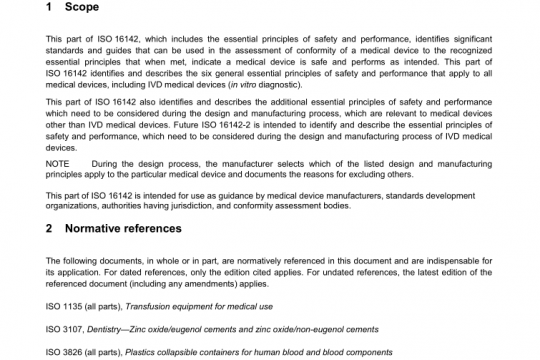AAMI ISO 23500-4 pdf free download
AAMI ISO 23500-4 pdf free download.Preparation and quality management of fuids for haemodialysis and related therapies— Part 4: Concentrates for haemodialysis and related therapies.
4 Requirements 4.1 Concentrates 4.1.1 Physical state The concentrate for haemodialysis can be supplied in dry or aqueous form. Packaging can be for direct use with a single dialysis machine or for use in systems supplying multiple dialysis machines (bulk use). 4.1.1.1 Liquid solute concentrations All electrolytes identified on the label shall be present within ± 5 % or ± 0,1 mEq/l (expressed as dialysis fluid concentrations), whichever is greater, of the stated concentration, with the exception of sodium, which shall be present within ± 2,5 % of the labelled concentration or shall be present according to approved specifications by the local regulations. If used, glucose shall be present within ± 5 % or ± 0,05 g/l (when measured as properly diluted dialysis fluid), whichever is greater, of the labelled concentration, or shall be present according to approved specifications by the local regulations. Where concentrates include non-traditional constituents, such as antioxidants and iron compounds, these constituents shall be present at nominal concentrations with ± 5 % tolerances or shall be present according to approved specifications by the local regulations. If alternate, locally approved tolerances are used, the tolerances shall be similarly stated and the rationale for their use documented. Most concentrates are manufactured with standard traditional chemicals such as sodium chloride, potassium chloride, magnesium chloride, calcium chloride, acetic acid, and glucose. New concentrates are available which include additional chemicals or in which certain chemicals have been substituted by others; for example, citric acid has been substituted for acetic acid. Where this occurs, the labelling shall correctly reflect this and the substitute chemicals shall be present at nominal concentrations with ± 5 % tolerances, or shall be present according to approved specifications by the local regulations. If alternate, locally approved tolerances are used, the tolerances shall be similarly stated and the rationale for their use documented. It is essential that the actual concentrations of the solutes contained in the concentrate be as close as possible to the labelled amount since the final composition of the dialysis fluid will be subject to cumulative variability from other sources within the process of dialysis fluid delivery (such as, but not confined to laboratory testing, mixing process or proportioning, dialysis water). 4.1.1.2 Solute concentrations based on powder When concentrate is packaged in dry form or a combination of dry and liquid and is mixed according to the manufacturer’s instruction for use, the final concentrate shall meet the requirements of 4.1.1.1. 4.1.2 Water The quality of water used in the manufacture of the concentrate shall be in accordance with ISO 23500-3. 4.1.3 Bacteriology of concentrates 4.1.3.1 Bacteriology of acid concentrates There are no published reports of acid concentrate supporting bacterial growth and as such, acid concentrate need not be tested for bacterial growth. 4.1.3.2 Bacteriology of bicarbonate concentrates Concentrate containing bicarbonate supplied as a liquid shall be provided in a sealed container and manufactured by a process validated to produce dialysis fluid meeting the microbiological requirements of ISO 23500-5, when used according to the manufacturer’s instructions. Bicarbonate powder intended for the preparation of concentrate at a dialysis facility shall be capable of producing dialysis fluid meeting the microbiological requirements of ISO 23500-5, when used according to the manufacturer’s instructions. 4.1.4 Endotoxin levels The concentrate shall be formulated and packaged using a process validated to produce dialysis fluid meeting the endotoxin requirements of ISO 23500-5 or the applicable pharmacopoeia when used according to the manufacturer’s instructions.AAMI ISO 23500-4 pdf download.
Other IEC Standards
-

ANSI AAMI ISO 16142-1 pdf free download – non-IVD medical devices and guidance on the selection of standards
AAMI standards list DOWNLOAD -

ANSI AAMI ISO 16142-2 pdf free download – General essential principles and additional specifc essential principles
AAMI standards list DOWNLOAD


